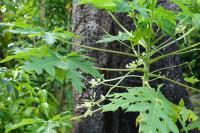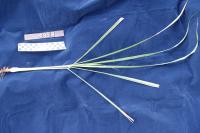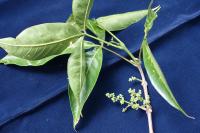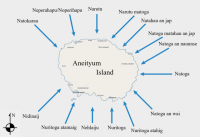This page has returned 100 entries
nese

n. herb to 4 m tall, male flowers white (collection: Michael J. Balick #4977)
Example: The fruits are edible and eaten when ripe. To soften beef or octopus, or other meat that is tough, chop green fruit and put in a bowl with meat/fish and then add some water. Allow to sit for 30 minutes or if the food needs to be softer, then leave it in longer. The leaves are used to feed lobsters that are being kept in cages underwater, following their harvest. The leaves are used to cover stones on the earth oven. To treat a person with Ciguatera illness, wash many very gren fruits of papaya, the smallest ones that form at the top, and eat these to help relieve symptoms.
bookmarknese

n. shrub to 2 m, flowers white. forest near house. (collection: Michael J. Balick #4871)
Example: A handful of flower buds are collected and put into water with 1-2 pieces of papaya roots. Heat the water and drink it hot for the treatment of hypertension or vein problems, or to promote circulation in overweight people. Do this treatment 1x a month. The white sap is collected and used to soften octopus flesh for eating. Put sap, fruits and chopped leaves in a bowl and add the octopus, allowing it to remain in the bowl for 1 hour--this will soften the flesh of the animal. The sap can be used to wash the skin of tough beef or wild pig--it helps to "burn" off (remove) the skin. When cooking tough meat, take young fruits of this tree and cut them up and put them in the pot with the meat, boil it to soften the meat which can then be cooked.
bookmarknese uinman

n. tree to 3 m tall, 20 cm dbh (collection: Michael J. Balick #4869)
Example: To treat toothaches, take a handful of leaves, boil them in 1 cup of water, take the warm liquid and leaves and wash or rinse the affected area as needed until pain resolves. The wood is used for carving and is yellowish in color. The stems are used to secure the outrigger to a traditional canoe.
bookmarknesei
n. forest
bookmarknesgan nevig
n. a fresh coconut
bookmarknesgin
n. the pith
bookmarkneta
n. cane (sugar)
bookmarknetcetas

netcetas

n. well branched tree, 15 m tall (collection: Gregory M. Plunkett #4084)
Example: 1. The name means "explosion". Further information about the plant withheld.
bookmarknetcetec

n. trees, 3-4 m tall (collection: Gregory M. Plunkett #3473)
Example: 1. This species is excellent for firewood as it gives off less smoke than other types of wood. 2. The wood is good for making roof rafters on which to tie thatch. 3. Use this for planting pole, for taro, cane, and kava.
bookmarknete
n. kind of tree
bookmarknete o un
n. west
bookmarknetehmu
n. kind of banana
bookmarknetemu

n. epiphyte on main trunk of Hernandia moerenhoutiana, pendant (1.7 m long) (collection: Gregory M. Plunkett #3648)
Example: Name means pile of fish. To protect a conservation area and restock it, collect pile of stems and leaves and put in a pool of water with stones on it. Fish will come and breed and area will have more fish. Fish in general
bookmarknetemu

netemu or nidwumnumu

neteng
n. Barringtonia asiatica L.
Example: inner bark: ground, added to dug pools in the sea as fish poison
bookmarknetet
n. the name of a tree
bookmarknetethae

n. shrub, 1. 5 m tall (collection: Gregory M. Plunkett #3604)
Example: The fruits are edible when ripe--eating them turns the tongue purple. 1. To cure headaches - Someone other than the woman must prepare this. Break the top branch of netethae and remove leaves for use. Combine with the top leaves of the top branch of nelmaha. Chew the leaves and drink the juice. Do this when the sun is setting on the horizon. The woman gives the leftover fibers to the person who prepared the medicine and that person goes and throws the fibers in the direction of the setting sun. 2. Ancestors 4 top branches and chew and spit out remaining fiber will destroy the effects of a love potion that is too strong – meaning that the husband or wife will miss the other person too much so that they become mentally ill. 3. Edible fruits: eating them turns tongue black/purple.
bookmarknetethei

n. shrub. Uncultivated around the village disturbed areas. . (collection: Ashley A McGuigan #27)
Example: The fruits are edible when ripe--eating them turns the tongue purple. 1. To cure headaches - Someone other than the woman must prepare this. Break the top branch of netethae and remove leaves for use. Combine with the top leaves of the top branch of nelmaha. Chew the leaves and drink the juice. Do this when the sun is setting on the horizon. The woman gives the leftover fibers to the person who prepared the medicine and that person goes and throws the fibers in the direction of the setting sun. 2. Ancestors 4 top branches and chew and spit out remaining fiber will destroy the effects of a love potion that is too strong – meaning that the husband or wife will miss the other person too much so that they become mentally ill. 3. Edible fruits: eating them turns tongue black/purple.
bookmarkneteukin
n. the name of a poisonous plant
bookmarknethedwoleg

n. shrub, 1. 5 m tall (collection: Gregory M. Plunkett #3557)
Example: For treatment of a stomach ache, or if your stomach "complains", take very young stems, break off the leaves and chew the stems and swallow the juice. Use a 3-5 cm pieces of stems, chew, and then it clears your intestines and will make you go to the toilet.
bookmarknethokin
n. a poisonous plant used to stupefy fish; also "netokin"
bookmarknethopdecraeñ

netigi

netit tidai
n. kind of plant, grass, or fern
bookmarknetjeñ

netohranmul
n. wind-related term; no definition provided
bookmarknetopdecraiñ

n. herb to 45 cm, seeds brown. Red clay soil (collection: Michael J. Balick #4888)
Example: The name of this plant means "division" -- if someone wants to help to destroy your business or home, they put this plant in front of your business or your home and this will help to scatter out your family from where they are living.
bookmarknetto
n. sugarcane
bookmarknetumtehi
n. kind of sugarcane
bookmarknetvo
n. a species of fruit
bookmarkneudan tauoc neaig
n. the center sprout of a coconut tree
bookmarkneudan tauoc nohos
n. the center sprout of the banana plant
bookmarkneuled
n. kind of sugarcane
bookmarkneusjai
n. a fern tree
bookmarknevak
n. prepared pandanus leaf
bookmarknevehev
n. current of air
bookmarkneyaiñ

neyo

n. grass to 70 cm tall, sterile. Cultivated at the side of a field. (collection: Michael J. Balick #4958)
Example: The leaves and stems are boiled in water to make tea. The base of the leaves (the whitish part) is used to cook foods that have a strong odor, such as goat or shark. The base is sliced and put in the soup and this helps to keep the smell of the goat or shark from infusing through the rest of the food and making it less palatable. In some areas of Aneityum, such as in cassava fields, there is a fungus that kills the crops. This species is interplanted with the crops to kill that fungus and protect the crop plants.
bookmarknhujac

niau
n. kind of plant, grass, or fern
bookmarknicasau
n. the castor-oil plant
bookmarknicvan neaig
n. kind of taro
bookmarknida

n. tree, 1. 5 m tall (collection: Gregory M. Plunkett #3685)
Example: Sharpen the end of a straight pole of this tree and use it to plant taro in a swampy area. For family planning. Scratch away the inner bark into your hand and mix with 1/4 cup salty water. Woman the uses (not specified how to use) it after her monthly period to protect her from getting pregnant.
bookmarknida

nidei
n. kind of sugarcane
bookmarknidel
n. a meteor; also "nidil"
bookmarknidi cai
n. frankincense
bookmarknidi yebeg

n. Humpback unicornfish
Example: Photo by Ross D. Robertson / Shorefishes of the Neotropics, License: CC BY-SA 3.0 via Fishes of Australia
bookmarknidiape
n. kind of sugarcane
bookmarknidid

n. Ambon emperor
Example: Photo by FAO / Fishbase, License: CC BY-NC 3.0 via Fishes of Australia
bookmarknididao
nidin
n. sap
bookmarknidincai
n. balsam; resin
bookmarknidintaueuc
n. new coconut leaves
bookmarkniditau

n. tree, 3 m tall (collection: Gregory M. Plunkett #3507)
Example: The young leaves and fruits are edible; the fruits are eaten ripe. This species is used for firewood as well as house posts, but they don’t last as long as other types of wood so they are used in temporary structures. A sacred plant on Aneityum. Name means linkage between this world and the spirit world. Agriculture – you find this tree ?? it means that the land is fertile. Birds eat fruits; people burn the tree to release ash and fertilizer and grow their taro around it – it will give more food. Message plant – if someone puts a long brown on your door or in your garden, it means “why are you here?” Implies that you should go back to where you belong. You don’t belong in this place. For example instead of quarreling over land dispute, put the branch and it means that you should leave this place.
bookmarkniditau

n. tree, 8 m tall (collection: Gregory M. Plunkett #3636)
Example: The green fruits are edible, as are the young leaf apices--cook these in water and eat them. The wood is used for temporary houses, for example, to provide shade in a garden. For planting taro, or any root crop, sharpen the end of a stick of this tree and use it for making holes, particuarly in river sand where some crops are planted. This tree grows near the river and is an indication that this land is good for agriculture. The wood from the tree is very good for firewood. Name means "who are you." Plant used as an indicator of a tabu place. Take a branch and put it where another person is building or gardening and there is a dispute over that area of land. When this plant is placed there the person who is using the land should stop working it.
bookmarkniditau

niditau

n. tree. Found in the village. (collection: Ashley A McGuigan #14)
Example: The young leaves and fruits are edible; the fruits are eaten ripe. This species is used for firewood as well as house posts, but they don’t last as long as other types of wood so they are used in temporary structures. A sacred plant on Aneityum. Name means linkage between this world and the spirit world. Agriculture – you find this tree growing, it means that the land is fertile. Birds eat fruits; people burn the tree to release ash and fertilizer and grow their taro around it – it will give more food. Message plant – if someone puts a long brown on your door or in your garden, it means “why are you here?” Implies that you should go back to where you belong. You don’t belong in this place. For example instead of quarreling over land dispute, put the branch and it means that you should leave this place.
bookmarkniditau

n. tree to 8 m, dbh 20 cm (collection: Michael J. Balick #4867)
Example: Fruits are sweet and edible when ripe. This plant is an indicator of rich soil, a good place to plant one’s garden. The leaves of this species are mixed in with other leaves for an unspecified local medicine that helps to remove spiritual sickness
bookmarknidman tal
n. a top of taro
bookmarknidnaiñ

niducai
n. kind of tree
bookmarkniducei

n. tree to 4 m, dbh 6 cm (collection: Michael J. Balick #4992)
Example: The stems of this plant are good for making temporary houses in the bush. When used as firewood, the stems are said to "hold the fire," meaning they burn a long time, even all night so in the morning the fire can be restarted by adding kindling. This wood is said to be good when a person has no matches, as the fire can be restarted easily. Young leaves of this species can be wrapped around ground coconut and eaten raw. The young leaves can also be boiled in water for 15 minutes, coconut milk added, and eaten with tubers such as cassava. The young leaves can be wrapped around beef or pork, tied with a string from Pandanus and cooked in the earth oven.
bookmarknidupau
n. kind of tree
bookmarknidwunitei

nidwunitei

n. tree fern, trunk 2 m tall (collection: Gregory M. Plunkett #4102)
Example: 1. There are kinds of this plant. This is considered the white one. See GMP #4100, Cyathea sp., which is considered the black one.
bookmarknieg
n. a reed
bookmarkniegred













